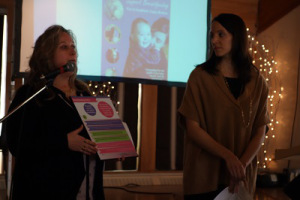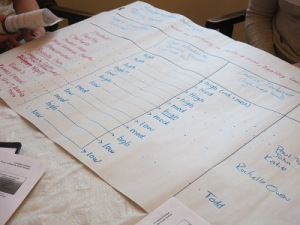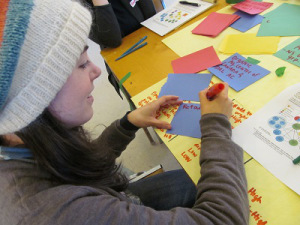Building on the success of last year’s Policy 101: Community Action Workshop, this year we decided to take the workshop on the road. We were in Amherst, Cape Breton (near Baddeck), and in Halifax to talk policy with individuals keen on making their institutions, municipalities and the province as a whole more supportive of healthy lifestyles, local food, and a sustainable environment.
The format of the day (or two evenings, in the case of the Halifax workshop) remained similar to last year’s workshop (which you can read about here). In short, we did a short presentation on demystifying policy, heard stories of policy change for members of the community, and then undertook a stakeholder analysis and policy mapping exercise using real life examples suggested by the participants.
Our Speakers
 We had a great slate of speakers at our workshops. Topics included:
We had a great slate of speakers at our workshops. Topics included:
- smoke-free outdoor public spaces
- the healthy food policy in the Colchester healthcare facilities
- healthy food policies for provincially funded institutions
- the Environmental Goals and Sustainable Prosperity Act
- breastfeeding friendly initiatives
- speed limits in school zones and other policies to support active transportation to schools
Every story of policy change is different, and yet certain elements remain the same. It’s key to engage diverse stakeholders, to take advantage of windows of opportunity, to be flexible and patient, and to have good research and human stories to illustrate the importance of this work.
In Halifax, law professor, and former city councillor and MLA, Howard Epstein joined us to share lessons he’s learned from both being an advocate and from being an elected official. His key advice was “be bold and be prepared”: ask for meetings with decision makers and ask for what you want, but before you go make sure you and your partners have done your homework and are asking for the same thing. Keep it pointed and leave behind succinct written material. Monitor current government thinking – what’s in the budget or the throne speech? Finally, be credible. Have solid research to back up your asks.
Stakeholder Analysis & Policy Mapping
 The key to the stakeholder analysis and policy mapping exercise is to get clear on what exactly you’re looking to change. Many of us go into advocacy work with big visions of the changes we want to see in the world. This is great – and we definitely shouldn’t lose this – but, as the saying goes, “the journey of a thousand miles begins with a single step”. So, what’s the first step? I often take groups through what I call “Policy Mad Libs”, where they fill in key words to create a starting point. In this case:
The key to the stakeholder analysis and policy mapping exercise is to get clear on what exactly you’re looking to change. Many of us go into advocacy work with big visions of the changes we want to see in the world. This is great – and we definitely shouldn’t lose this – but, as the saying goes, “the journey of a thousand miles begins with a single step”. So, what’s the first step? I often take groups through what I call “Policy Mad Libs”, where they fill in key words to create a starting point. In this case:
I want my _______________ to ____________ a policy to ______________.
First blank: institution, organization, municipal government, provincial government, etc.
Second blank: adopt,create, change, stop
Third blank: what do you want the policy to do?
Here are some examples of statements we worked with:
- I want my university to adopt a policy to bring healthier, local, sustainable food to campus.
- I want the NS Department of Education to create a policy integrate mandatory food skills and food literacy education into the curriculum.
- I want our municipality to adopt a local food charter.
- I want the province of Nova Scotia to create a provincial organic regulation which regulates organic claims made within the province.
- I want the municipality to create a policy to encourage healthy food at its events and festivals.
Next, the groups identified and analysed the stakeholders affected by their given policy goal. Who is a stakeholder in this issue? To what degree are they affected by the policy (low, medium or high)? And how much influence do they have (low, medium or high)? For example, if you were trying to develop a municipal food strategy, stakeholders could include, among others, city councillors, public health, the food bank and the local community garden organization.
 After listing the stakeholders, the next step is to map the policy context and decision points, including gatekeepers, potential policy leaders, potential allies and potential resistance. The policy map helps to identify spaces and pathways (e.g.opportunities) for participation and influence in policy change. The point is not to get a map that is “right” but to get a clearer idea of who you might need to influence in order to achieve your policy goal. The goal of policy mapping is also to start the conversation about the different paths to creating change. It is only one step in strategizing towards change. Through the activities, participants began to see who they should reach out to and who might have the power to change the problem.
After listing the stakeholders, the next step is to map the policy context and decision points, including gatekeepers, potential policy leaders, potential allies and potential resistance. The policy map helps to identify spaces and pathways (e.g.opportunities) for participation and influence in policy change. The point is not to get a map that is “right” but to get a clearer idea of who you might need to influence in order to achieve your policy goal. The goal of policy mapping is also to start the conversation about the different paths to creating change. It is only one step in strategizing towards change. Through the activities, participants began to see who they should reach out to and who might have the power to change the problem.
Participants went home with colourful maps of their routes to policy change – some even said that they would hang the map on the wall of their office!
A big thanks to everyone who spoke or participated and good luck with your initiatives!
-Marla MacLeod



